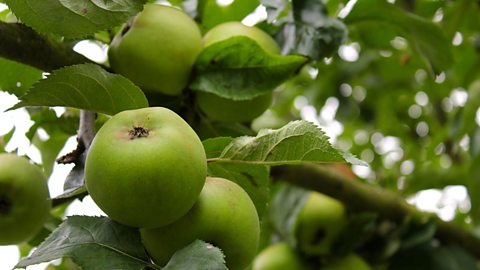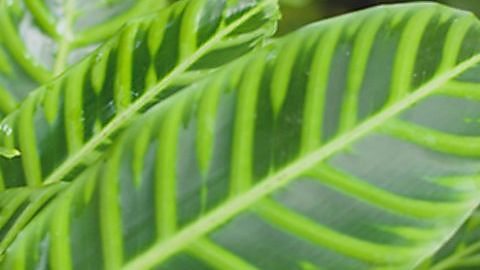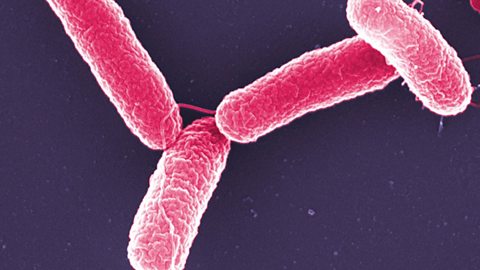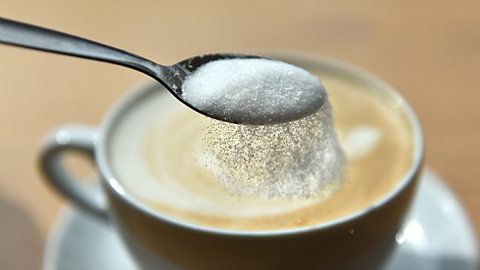Key points
- Cells are the smallest unit of life.
- Cells in multicellular plants and animals are arranged into tissues, organs and organ systems.
Levels of organisation
Video
VOICEOVER: Multicellular organisms are organised into increasingly complex parts…
Cells. Tissues. Organs. Organ systems. And the organism itself.
Cells are the building blocks of life. Tissue is made when specialised cells with the same function group together.
For example, millions of muscle cells make up muscle tissue.
An organ is made from two or more tissues, which all work together to do a particular job, like the heart in animals or a leaf in a plant.
An organ system is made of a group of organs which all work together to do a particular job, such as the nose, trachea, bronchi and lungs which all make up the gas exchange system.
Mr Shribman: Yeah, so one of the systems in the human body is the digestive system. Ours is simpler than some other animals', like cows and deer have multiple stomachs, we just have the one.
Gethin: So as you can see, there are lots of tissues and organs that make up our digestive system but what's the difference between them?
Mr Shribman: So, yeah, these are some key things on your school syllabus.
Firstly, you need to know that a tissue is a group of cells in the same place all doing the same thing. There are loads of cells in your mouth making saliva. Imagine if the saliva-making tissue all disappeared – you'd have the driest mouth in the world.
Gethin: I sometimes get that when I'm nervous on television, but anyway, how about an organ, then?
Mr Shribman: So organs are these things here like the stomach and liver. They do an overall job. There's an amazing organ called a spleen, that can help you hold your breath underwater for longer if you have a really big one.
Penguins have massive spleens.
Anyway, you need to know that an organ is a group of different tissues working together to achieve an overall goal.
Gethin: OK, gotcha. So we know what a tissue and an organ is. What about a system?
Mr Shribman: A system is a group of organs that work together to do an overall task. So our nervous system is our brain and all our nerves, and that allows us to think, feel, move, dance and so on.
Our digestive system allows us to eat delicious food, digest it - which means break it down and absorb it.
Speaking of which, there's a guy in France who once ate an entire plane by breaking it into tiny pieces, but I would not advise that at all.
Gethin: Is that true? That's astonishing! OK, I definitely wouldn't do that. All right, so a bit of a recap for us on this.
Mr Shribman: So to recap, cells make tissues, tissues make organs, and organs make systems. Some living things are made from a single cell. We call them unicellular – like a unicycle but with a cell – and they don't have to worry about any of this because they're just a cell.
We're multicellular, which means loads of cells all together miraculously forming working human beings like ourselves.
multicellularMade from more than one cell. Can refer to an organism. animals and plants consist of different types of cells organised in a hierarchy as tissues, organs and systems.
Cells
Cells are the smallest unit of life. Most cells have features which give them different functions within an organism.
Humans are multicellular. That means 'made of lots of cells', not just one cell. The cells in many multicellular animals and plants are specialised, so that they can share out the processes of life. These cells all work together to keep the organism alive.
Plants
Examples of specialised cells in plants include:
Palisade leaf cells: these are found towards the tops of leaves and are packed with green chloroplasts in which photosynthesisA chemical reaction that occurs in the chloroplasts of plants in which the energy in light is stored in glucose. occurs.
Root hair cells: cells containing a hair-like structure that pokes into the soil to absorb more water and nutrients.
Animals
Examples of specialised cells in animals include:
- Ovum - egg cell: contains half of an organism’s genetic information - DNA - which will join with the sperm during fertilisation.
- Sperm: transfers genes from male body during sexual reproduction.
- Ciliated cells: these have tiny hairs - cilia - on their surface that beat in a rhythmical pattern. For example, they move mucus from the airway to the mouth to swallow. They also move an ovum through the female reproductive system.
- Red blood cells: carry oxygen to body tissues that need it.
Tissues

A group of similar cells in the same place with the same function is a tissue.
Plants
In plants, dermal tissue covers the leaves, fruits, flowers, roots and stems of plants. Dermal tissue stops the plant from losing too much water.
Animals
Examples of tissues in animals include muscle tissue and nerve tissue.
- Muscle tissue: made of muscle cells that can contract and relax to move parts of the body.
- Nerve tissue: made of nerves, found in the brain and spinal cord, and the network of nerves that spreads throughout the body. It sends electrical signals to control and coordinate actions.

Organs
A group of tissues in the same place with the same function is an organ.
Plants
Roots are plant organs. They keep plants securely in the ground and are covered with root hair cells which absorb water and nutrients from the soil. Other plant organs are leaves, stems and flowers.
Animals
The heart is an organ made from muscle and nerve tissue and pumps blood around the body. Other examples of animal organs include the liver, brain, lungs, stomach, intestines, kidneys, bladder and skin.
Activity - Label the plant organs
Activity - Label the human organs
Organ systems
Two or more organs with the same function is an organ system.
Plants
Plants have two organ systems.
- The shoot organ system in a plant is made from leaves, stems, buds, fruits and flowers.
- The root organ system of most plants are all the parts that are underground.
Animals
There are 11 organ systems in the human body that each have a different function. Here are some examples:
| Organ system | Main organs | Function |
|---|---|---|
| Circulatory | Heart, veins, arteries | Transports substances in the blood around the body |
| Respiratory | Lungs | Takes in oxygen, removes carbon dioxide |
| Digestive | Stomach and intestines | Breaks down food, absorbs nutrients |
| Reproductive | Uterus, vagina. Penis, testes | Creates offspring |
Test your knowledge
Teaching resources
Looking for more teaching resources? This collection of videos introduces key concepts in biology, focussing on the seven important lessons from the natural world with beautiful wildlife footage.
BBC Teach has thousands of free, curriculum-linked resources to help deliver lessons - all arranged by subject and age group.
GCSE exam dates 2025
Find out everything you need to know about the 2025 GCSE exams including dates, timetables and changes to exams to get your revision in shape.

More on Living organisms
Find out more by working through a topic
- count10 of 15

- count11 of 15

- count12 of 15

- count13 of 15
